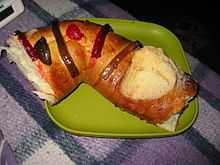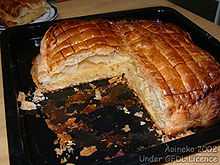King cake
| King cake | |
|---|---|
| Cake | |
 Louisiana-style King Cake. The baby figurine is seen in the middle of the roll | |
| Alternative name(s): | |
| Kingcake, kings' cake, king's cake, three kings cake, galette des rois | |
| Recipes at Wikibooks: | |
|
| |
| Media at Wikimedia Commons: | |
|
|
A king cake (sometimes rendered as kingcake, kings' cake, king's cake, or three kings cake) is a type of cake associated in a number of countries with the festival of Epiphany at the end of the Christmas season, and in other places with the pre-Lenten celebrations of Mardi Gras / Carnival.
The cake often has a small plastic baby (said to represent Baby Jesus) inside (or sometimes placed underneath), and the person who gets the piece of cake with the trinket has various privileges and obligations.
History

The "king cake" takes its name from the biblical three kings. In Catholic liturgical tradition, the Solemnity of Epiphany - commemorated on January 6 - celebrates the visit of the Magi to the Christ Child. The Eve of Epiphany (the night of January 5) is popularly known as Twelfth Night (the Twelve Days of Christmas are counted from Christmas Eve until this night). The season for king cake extends from the end of the Twelve Days of Christmas (Twelfth Night and Epiphany Day), up until Mardi Gras, or "Fat Tuesday;" the day before the start of Lent. Some organizations or groups of friends may have "king cake parties" every week through the Carnival season. In Portugal and France, whoever gets the King cake trinket is expected to buy the next cake for these get-togethers.
It is a popular food item during the Christmas season (Christmas Eve to Epiphany) in Belgium, France, Quebec and Switzerland (galette or gâteau des Rois or galette des rois), Portugal (bolo rei), Spain, and Spanish America (roscón or rosca de reyes and tortell in Catalonia), Greece and Cyprus (vasilopita) and Bulgaria (banitsa). In the United States, Carnival is traditionally observed in the Southeastern region of the country, particularly in New Orleans, Mobile, Pensacola, Galveston, and other towns and cities of the Mississippi Gulf Coast. In this region, the king cake is closely associated with Mardi Gras traditions and is served throughout the Carnival season, which lasts from Epiphany Eve to Fat Tuesday.
Related culinary traditions are the tortell of Catalonia, the gâteau des Rois or reiaume in Provence or the galette des Rois in the northern half of France, and the Greek and Cypriot vasilopita. The galette des Rois is made with puff pastry and frangipane (while the gâteau des Rois is made with brioche and candied fruits). A little bean was traditionally hidden in it, a custom taken from the Saturnalia in the Roman Empire: the one who stumbled upon the bean was called "king of the feast." In the galette des Rois, since 1870 the beans have been replaced first by porcelain and now by plastic figurines. The gâteau des Rois is known as Rosca de Reyes in Mexico.
Samuel Pepys recorded a party in London on Epiphany night, 6 January 1659/1660, and described the role the cake played in the choosing of a "King" and "Queen" for the occasion: "...to my cousin Stradwick, where, after a good supper, there being there my father, mothers, brothers, and sister, my cousin Scott and his wife, Mr. Drawwater and his wife, and her brother, Mr. Stradwick, we had a brave cake brought us, and in the choosing, Pall was Queen and Mr. Stradwick was King. After that my wife and I bid adieu and came home, it being still a great frost."[1] The choosing of King and Queen from the pie, usually by the inclusion of a bean and a pea, was a traditional English Twelfth Night festivity. The cake was called a "Twelfth Cake", "Twelfth-night cake", or "Twelfth-tide cake".[2]
Trinket

The traditional trinket in the cake is a fava bean, still seen in some European and Mexican traditions but rare in U.S. king cakes. It is echoed, however, in some krewes' use of a gilded bean trinket.
In the U.S. Gulf Coast since the 1950s, the most common trinket has been a small plastic baby doll. Earlier ceramic baby boys as trinkets are documented in New Orleans back to the 1930s. A king wearing a crown is the next most common trinket. Other figures have been seen historically, and starting in the 1990s again became more common in the more expensive "gourmet" varieties of king cake. In New Orleans in recent years, figurines are sold in the shape of a breast or penis, or depict a man or woman in a lascivious pose. The common plastic baby of today is usually colored pink, brown, white or gold. Because of the potential choking hazard, some bakeries include the trinket separately from the pastry.
Gulf Coast king cake
In the southern United States, the tradition was brought to the area by colonists from France and Spain and is associated with Carnival (also known as Mardi Gras). Celebrated across the Gulf Coast region from the Florida Panhandle to East Texas, it originated in French Louisiana and King cake parties in New Orleans are documented back to the eighteenth century.
The king cake of the Louisiana tradition comes in a number of styles. The most simple, said to be the most traditional, is a ring of twisted cinnamon roll-style bread topped with icing or sugar, usually colored purple, green, and gold (the traditional Mardi Gras colors) with food coloring. In 1972, a small bakery in Picayune, Mississippi, Paul's Pastry, started adding fillings to king cakes - the most common being cream cheese, praline, cinnamon, or strawberry. A so-called "Zulu King Cake" has chocolate icing with a coconut filling, because the Krewe of Zulu parade's most celebrated throw is a coconut. Also, some bakers have now taken the liberty to offer king cakes for other holidays that immediately surround Mardi Gras season, such as green and red-icing king cakes for Christmas, red and pink-icing cakes for Valentine's Day, and green and white-icing cakes for St. Patrick's Day. Others have gone a step further and produce specialty king cakes from the beginning of football season for Louisiana State University and New Orleans Saints tailgate parties, then for Halloween, then Thanksgiving - and do not cease until after Mardi Gras season with an Easter holiday king cake. It has become customary in the Southern culture that whoever finds the trinket must provide the next king cake or host the next Mardi Gras party.
King cake in Spanish-speaking countries

The roscón de reyes in Spain or rosca de reyes in Latin America is traditionally eaten on January 6, during the celebration of the Día de los reyes magos (the "Day of the Three Wisemen"). In most of Spain, Mexico and in Latino communities in the United States, this is the day when children get presents from the Three Wise Men. Before going to bed, children in Mexico leave a shoe outside their home, filled with hay or dried grass and a bowl of water as a present for the animals the reyes ride, along with a note for the reyes. The rosca de reyes has an oval shape to symbolize a crown. For decoration, people sometimes use dried and candied fruits such as figs, quince or cherries. The fruit symbolizes the many jewels that a crown would have.
The tradition of placing a bean, candy or figurine of the baby Jesus inside the cake is followed. Whoever finds it must take it to the nearest church on February 2, Día de la candelaria (Candlemas Day), which celebrates the presentation of Jesus in the Temple. According to the Jewish tradition, an infant was to be presented to God in the Temple forty days after his birth. The use of candles on Candlemas represents the light of Christ presented to the world. In Mexico and the Mexican diaspora in the United States, people who find the baby Jesus figurine in their piece of cake usually agree to host a party on Candlemas (February 2) and to provide the guests with tamales and atole.[3]
In Argentina, the tradition of consuming a rosca on January 6 is also followed, although no figurine is included. In addition, a similar version with whole cooked eggs on top of the cake is also served on Easter as rosca de Pascua.
In some places, the rosca de reyes is replaced by panettone.
French king cake


The cake traditionally celebrating Epiphany in France and Quebec is sold in most bakeries during the month of January. Two versions exist: in northern France and Quebec the cake called galette des rois (which can be either circular or rectangular) consists of flaky puff pastry layers with a dense center of frangipane. In southern France - Occitania, Roussillon, Provence, Catalan where it´s called tortell - the cake called gâteau des rois or royaume, is a torus-shaped brioche with candied fruits and sugar, similar in its shape and colours to a crown. This later version is also common to Spain and very similar to New-Orleans king cake.
Tradition holds that the cake is “to draw the kings” to the Epiphany. A figurine, la fève, which can represent anything from a car to a cartoon character, is hidden in the cake and the person who finds the trinket in their slice becomes king for the day and will have to offer the next cake. Originally, la fève was literally a broad bean (fève), but it was replaced in 1870 by a variety of figurines out of porcelain or—more recently—plastic. These figurines have become popular collectibles and can often be bought separately. Individual bakeries may offer a specialized line of fèves depicting diverse themes from great works of art to classic movie stars and popular cartoon characters. The cakes are usually sold in special bags, some of which can be used to heat the cake in a microwave without ruining the crispness of the cake. A paper crown is included with the cake to crown the "king" who finds the fève in their piece of cake. To ensure a random distribution of the cake shares, it is traditional for the youngest person to place themselves under the table and name the recipient of the share which is indicated by the person in charge of the service.
Formerly, one divided the cake in as many shares as guests, plus one. The latter, called "the share of God," "share of the Virgin Mary," or "share of the poor" was intended for the first poor person to arrive at the home.
The French President is not allowed to “draw the kings” on Epiphany because of the etiquette rules. Therefore, a traditional galette without figurine or crown is served at Elysée Palace in January. [citation needed]
See also
References
- ↑ Diary of Samuel Pepys
- ↑ Oxford English Dictionary, 1st edition, 1916, s.v.
- ↑ "Happy Candlemas! ¡Feliz Día de la Candelaria!". Is Cancun Safe? - Cancun and Riviera Maya are safe and beautiful places to visit. NeuMedia. Retrieved 2 March 2011.
Sources
- "Christmas". Catholic Encyclopedia. Retrieved December 22, 2005. Primarily subhead Popular Merrymaking under Liturgy and Custom.
- Christmas Trivia edited by Jennie Miller Helderman, Mary Caulkins. Gramercy, 2002
- Marix-Evans, Martin. The Twelve Days of Christmas. Peter Pauper Press, 2002
- Bowler, Gerry. The World Encyclopedia of Christmas. McClelland & Stewart, 2004
- Collins, Ace. Stories Behind the Great Traditions of Christmas. Zondervan, 2003
External links
| Wikimedia Commons has media related to King cake. |
- A State Mandated Christmas Bonus a blog mentioning a "Rosca de reyes," a Hispanic king cake, by the Law Library of Congress
- King Cake: A Rich Tradition: How a toothsome treat became one of the most universal, and hungered for, symbols of Mardi Gras and New Orleans.
| |||||||||||||||||||||||||||||
| ||||||||||||||||||||||
